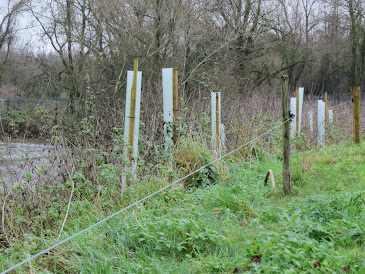Having not visited the area for a while, I decided it was time to look at some of the lakes that lie on the river Gipping. Winter is a good time to visit as this time of the year brings in more birds to their waters, with the chance of something unusual. I didn't go as far north as Pipps Ford, my usual focal point, rather I visited the area from Shamford Mere south to Barham Pits.
Sharmford Mere and Causeway Lake
These two small bodies of water are a bit out of the way, as there's no nearby road (as long as you don't count the A14, which forms an eastern boundary). They are both small bodies of water with natural surroundings, Causeway Lake is fished but Shamford isn't. The area is surrounded by cow pasture, and the river Gipping, which was bursting with water.
Star birds here today were a flock of 11 WHITE FRONTED GEESE, which were feeding in the cow field which separates the two waters. They are part of a larger national incursion of this species this winter, with many being seen inland. Coastal Suffolk is a national stronghold, but away from those reserves, and inland, the birds are quite rare. A definite first for the area.
There is a large herd of GREYLAG and CANADA GEESE in the area and they were all on Shamford. Also present there were two MUTE SWANS and 42 MALLARDS. Although mallards are our most common duck, this represents a good count for the Mere, made of genuinely wild birds and not escaped farmland birds as you would see on a village pond.
There wasn't much fishing on Causeway Lake today, which meant a decent number of birds were present with 20 TUFTED DUCK, 21 COOT, 5 GREAT CRESTED GREBE and 2 MUTE SWANS. On the river Gipping I heard, but unfortunately didn't see a KINGFISHER, and I saw a GREY WAGTAIL, both very much specialist birds of this river. In the riverside alders a MISTLE THRUSH had started to sing. One of our earliest songsters, they often start singing at the end of December in mild winters.
Barham Pits
Wow what has happened to this site? Since the pits were bought up in 2018, a lot has occurred. Firstly on Barham Pit B they fenced off the site, so you couldn't walk around anymore, with access being restricted to the footpath on the western side. Then they started cutting down all the trees, absolutely decimating the area. The place looks very naked now and not for the best. The footpath stated above has been used as an approach road, so somehow you have to squeeze in tight as a van full of fishing gear drives down it. This winter the path has been made impassable, used by machinery to destroy more habitat, creating an absolute quagmire. Ok, so the site was never that good bird-wise, but its still frustrating to see a place I visit regularly put under such pressure, something that's beyond my control.
Now they have started on Pit A. The small area of reedbed and wet woodland has been bulldozed to leave an area of mud, and they have cut down most of the water side trees. Surely fish need a variety of different habitats to live out their life cycles, but no, apparently what they need are a sterile environment like the one being created here. This is what happens when people who have no idea of looking after the environment, people who think maintenance of nature is to destroy it rather than to work with it. Such a shame, and one that's too common in the countryside.
Today, the star bird, and a good one for the area, was a GREAT SCAUP on Pit B. It was the only duck present, except for a couple of mallards. There were also a couple of GREBES and COOT, but the waters were fairly quiet.






No comments:
Post a Comment